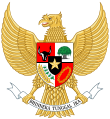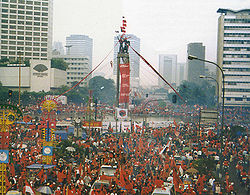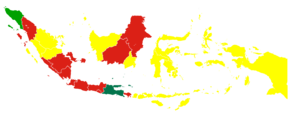1999 Indonesian legislative election
| ||||||||||||||||||||||||||||||||||||||||||||||||||||||||||||||||||||||||||||||||||||||||||||||||||||||||||||||||||||
462 of the 500 seats in the House of Representatives 232 seats needed for a majority | ||||||||||||||||||||||||||||||||||||||||||||||||||||||||||||||||||||||||||||||||||||||||||||||||||||||||||||||||||||
This lists parties that won seats. See the complete results below.
| ||||||||||||||||||||||||||||||||||||||||||||||||||||||||||||||||||||||||||||||||||||||||||||||||||||||||||||||||||||
| This article is part of a series on the |
| Politics of Indonesia |
|---|
 |
Early legislative elections were held in Indonesia on 7 June 1999. They were the first elections since the fall of Suharto and end of the New Order, the first free elections in Indonesia since 1955, and the first and only free legislative election held in East Timor during Indonesian provincehood. With the ending of restrictions on political activity following the fall of Suharto, a total of 48 parties contested the 462 seats up for election in the People's Representative Council. A further 38 seats were reserved for members of the armed forces.
Background
[edit]Under the New Order, only two political parties forcibly merged in 1973 – Indonesian Democratic Party (PDI) and United Development Party (PPP) – plus the functional group Golkar had been allowed to participate in elections.[1][2] With the start of the Reform Era, more than 100 new political parties emerged.[3] New elections were called for 1999 and 148 parties registered with the Ministry of Justice and Human Rights. Of these, only 48 passed the selection process, overseen by intellectual Nurcholish Madjid.[4][5] The elections were to be overseen by an independent General Elections Commission (KPU) of 53 members, one from each party and five government representatives.[6]
Electoral system
[edit]The system used was based on closed party-list proportional representation at the provincial level. Within each province, parties were awarded seats in proportion to their share of the vote. The East Java province had the most number of seats, with 82, while the lowest was in Bengkulu and East Timor with four each.[7]
Campaign
[edit]
The official election campaign began on 19 May 1999 and ended on 4 June to allow two 'rest days' before the vote itself. It was divided into three stages, with different parties being allowed to campaign on different days.[8] However, before the campaign, there was violence between supporters of rival parties. Four people were killed in fighting between followers of the United Development Party (PPP) and the National Awakening Party (PKB) on 1 May and three more died in clashes between Golkar and Indonesian Democratic Party of Struggle (PDI-P) supporters on 11 May.[9][10][11]
On the first day of the campaign there was a parade of party vehicles in Central Jakarta. The Golkar float was attacked and damaged[12] The traffic circle in front of Hotel Indonesia was a popular spot for rallies.[13][14][15] Meanwhile, there was an increase of people heading for Singapore to escape possible violence as polling day neared, with one newspaper reporting that more than 78,000 people had left.[16]
As well as rallies, the major parties took out full-colour advertisements in newspapers. Each party was also given air time TV for statements by lone spokespeople. There were also ads in the newspapers urging people to use their vote.[17][18]
In the final week, the main parties held huge rallies in the capital: the PKB on 1 June, the National Mandate Party (PAN) on 2 June, the PDI-P on 3 June and Golkar on 4 June, at which its supporters were attacked.[18][19][20][21]
At one minute past midnight on 5 June, all party flags, banners and posters began to be removed as the campaign officially ended. International observers continued to arrive to oversee the election, among them former US president Jimmy Carter.[11][21]
Polling day
[edit]In the last few days before the vote on 7 June, newspapers carried advertisements sponsored by the Indonesian Election Committee (PPI) explaining how to vote and urging people to do so.[22]
On the day itself, polls opened at 8 am. People cast their vote by piercing the party symbol on the ballot paper and then dipped a finger in indelible ink to prevent repeat voting. When the votes were counted, each ballot paper was held up for onlookers to see.[23][24]
There was independent monitoring down to the level of polling stations by Indonesians as well as by 100 observers and support staff from 23 counties led by Jimmy Carter.[23] On polling day, Carter said that it would have been extremely difficult to manipulate the election data because of the well-prepared information network and because the information was easy to access.[25] One way the public could access the latest results was by sending a short message service text to a specific number. The sender then received information about provincial or party results.[26]
On 9 June, Carter's team reported that although there had been "shortcomings" and allegations of financial abuses, they did not appear to have had a significant impact on the polling day activities.[27]
Results
[edit]The count was slow, with votes taking several weeks to count. Before he left Indonesia, Carter expressed his concern about this.[28] At a meeting at the General Election Commission building on 26 June, only 22 of the 53 members of the commission were prepared to accept the result. These comprised the representatives of 17 of the parties (with 93% of the vote between them) and the five government representatives. Eventually, later that same day President Bacharuddin Jusuf Habibie in a live TV broadcast declared the results were valid. The PDI-P, led by Megawati Sukarnoputri, had won the largest share of the vote with Golkar in second place.
The process of allocating seats in the People's Representative Council took several months with the PPI announcing the results on 1 September. A total of 21 parties had won seats, with the PDI-P winning 153 and Golkar 120. There were ten parties with only one seat each.[29]
Results by province
[edit]| Province | Total seats |
Seats won | ||||||||||||||||||||
|---|---|---|---|---|---|---|---|---|---|---|---|---|---|---|---|---|---|---|---|---|---|---|
| PDI–P | Golkar | PPP | PKB | PAN | PBB | PK | PDKB | PNU | PKP | PDI | PDR | PKD | PKU | PSII | Masyumi | PNIFM | IPKI | PNIMM | PBI | PP | ||
| Aceh | 12 | 2 | 2 | 4 | 0 | 2 | 1 | 0 | 0 | 1 | 0 | 0 | 0 | 0 | 0 | 0 | 0 | 0 | 0 | 0 | 0 | 0 |
| North Sumatra | 24 | 10 | 5 | 3 | 1 | 2 | 1 | 0 | 1 | 0 | 1 | 0 | 0 | 0 | 0 | 0 | 0 | 0 | 0 | 0 | 0 | 0 |
| West Sumatra | 14 | 2 | 4 | 3 | 0 | 3 | 1 | 1 | 0 | 0 | 0 | 0 | 0 | 0 | 0 | 0 | 0 | 0 | 0 | 0 | 0 | 0 |
| Riau | 9 | 3 | 3 | 1 | 1 | 1 | 0 | 0 | 0 | 0 | 0 | 0 | 0 | 0 | 0 | 0 | 0 | 0 | 0 | 0 | 0 | 0 |
| Jambi | 6 | 2 | 2 | 1 | 0 | 1 | 0 | 0 | 0 | 0 | 0 | 0 | 0 | 0 | 0 | 0 | 0 | 0 | 0 | 0 | 0 | 0 |
| South Sumatra | 15 | 6 | 4 | 2 | 1 | 1 | 1 | 0 | 0 | 0 | 0 | 0 | 0 | 0 | 0 | 0 | 0 | 0 | 0 | 0 | 0 | 0 |
| Bengkulu | 4 | 1 | 1 | 1 | 0 | 1 | 0 | 0 | 0 | 0 | 0 | 0 | 0 | 0 | 0 | 0 | 0 | 0 | 0 | 0 | 0 | 0 |
| Lampung | 15 | 6 | 3 | 1 | 2 | 1 | 0 | 1 | 0 | 1 | 0 | 0 | 0 | 0 | 0 | 0 | 0 | 0 | 0 | 0 | 0 | 0 |
| Jakarta | 18 | 7 | 2 | 3 | 1 | 3 | 1 | 1 | 0 | 0 | 0 | 0 | 0 | 0 | 0 | 0 | 0 | 0 | 0 | 0 | 0 | 0 |
| West Java | 82 | 27 | 20 | 13 | 6 | 6 | 3 | 2 | 0 | 1 | 1 | 0 | 0 | 0 | 0 | 1 | 1 | 0 | 0 | 0 | 0 | 1 |
| Central Java | 60 | 26 | 8 | 7 | 10 | 4 | 1 | 1 | 0 | 0 | 1 | 0 | 0 | 0 | 0 | 0 | 0 | 1 | 0 | 1 | 0 | 0 |
| Yogyakarta | 6 | 2 | 1 | 1 | 1 | 1 | 0 | 0 | 0 | 0 | 0 | 0 | 0 | 0 | 0 | 0 | 0 | 0 | 0 | 0 | 0 | 0 |
| East Java | 68 | 23 | 9 | 4 | 24 | 3 | 1 | 1 | 0 | 1 | 1 | 0 | 0 | 0 | 1 | 0 | 0 | 0 | 0 | 0 | 0 | 0 |
| Bali | 9 | 7 | 1 | 0 | 1 | 0 | 0 | 0 | 0 | 0 | 0 | 0 | 0 | 0 | 0 | 0 | 0 | 0 | 0 | 0 | 0 | 0 |
| West Nusa Tenggara | 9 | 1 | 4 | 1 | 0 | 1 | 1 | 0 | 0 | 0 | 0 | 0 | 1 | 0 | 0 | 0 | 0 | 0 | 0 | 0 | 0 | 0 |
| East Nusa Tenggara | 13 | 5 | 6 | 1 | 0 | 0 | 0 | 0 | 1 | 0 | 0 | 0 | 0 | 0 | 0 | 0 | 0 | 0 | 0 | 0 | 0 | 0 |
| East Timor | 4 | 2 | 2 | 0 | 0 | 0 | 0 | 0 | 0 | 0 | 0 | 0 | 0 | 0 | 0 | 0 | 0 | 0 | 0 | 0 | 0 | 0 |
| West Kalimantan | 9 | 2 | 3 | 1 | 0 | 0 | 0 | 0 | 1 | 0 | 0 | 1 | 0 | 0 | 0 | 0 | 0 | 0 | 0 | 0 | 1 | 0 |
| Central Kalimantan | 6 | 2 | 2 | 1 | 1 | 0 | 0 | 0 | 0 | 0 | 0 | 0 | 0 | 0 | 0 | 0 | 0 | 0 | 0 | 0 | 0 | 0 |
| South Kalimantan | 11 | 2 | 3 | 2 | 1 | 1 | 1 | 0 | 0 | 1 | 0 | 0 | 0 | 0 | 0 | 0 | 0 | 0 | 0 | 0 | 0 | 0 |
| East Kalimantan | 7 | 3 | 2 | 1 | 0 | 1 | 0 | 0 | 0 | 0 | 0 | 0 | 0 | 0 | 0 | 0 | 0 | 0 | 0 | 0 | 0 | 0 |
| North Sulawesi | 7 | 2 | 4 | 1 | 0 | 0 | 0 | 0 | 0 | 0 | 0 | 0 | 0 | 0 | 0 | 0 | 0 | 0 | 0 | 0 | 0 | 0 |
| Central Sulawesi | 5 | 1 | 3 | 1 | 0 | 0 | 0 | 0 | 0 | 0 | 0 | 0 | 0 | 0 | 0 | 0 | 0 | 0 | 0 | 0 | 0 | 0 |
| South Sulawesi | 25 | 2 | 16 | 3 | 1 | 1 | 1 | 0 | 0 | 0 | 0 | 0 | 0 | 0 | 0 | 0 | 0 | 0 | 1 | 0 | 0 | 0 |
| Southeast Sulawesi | 5 | 1 | 3 | 1 | 0 | 0 | 0 | 0 | 0 | 0 | 0 | 0 | 0 | 0 | 0 | 0 | 0 | 0 | 0 | 0 | 0 | 0 |
| Maluku | 6 | 2 | 2 | 1 | 0 | 0 | 0 | 0 | 1 | 0 | 0 | 0 | 0 | 0 | 0 | 0 | 0 | 0 | 0 | 0 | 0 | 0 |
| Irian Jaya | 13 | 4 | 5 | 0 | 0 | 1 | 0 | 0 | 1 | 0 | 0 | 1 | 0 | 1 | 0 | 0 | 0 | 0 | 0 | 0 | 0 | 0 |
| Total | 462 | 153 | 120 | 58 | 51 | 34 | 13 | 7 | 5 | 5 | 4 | 2 | 1 | 1 | 1 | 1 | 1 | 1 | 1 | 1 | 1 | 1 |
| Sources: Psephos, Pemilu.asia | ||||||||||||||||||||||
Presidential election
[edit]On 20 and 21 October 1999, about four months after the legislative elections, the People's Consultative Assembly elected the President and Vice President of Indonesia for the 1999–2004 term. Abdurrahman Wahid was elected president and Megawati Sukarnoputri as vice president.
References
[edit]Footnotes
[edit]- ^ Liddle (1978) p40
- ^ Evans (2003) pp. 21-21
- ^ Evans (2003) p28
- ^ Friend (2003) p406
- ^ Salomo et al.(2004) p.xxxv
- ^ Kompas 27 July 1999
- ^ Evans (2003) pp. 126-127
- ^ Kompas 29 April 1999 p40
- ^ Kompas 2 May 1999
- ^ Sinar Indonesia Baru 12 May 1999
- ^ a b Kompas 6 June 1999
- ^ Kompas 20 May 1999
- ^ Kompas 24 May 1999
- ^ Kompas 1 June 1999
- ^ Friend (2003) p412
- ^ Sinar Indonesia Baru 30 May 1999
- ^ Friend (2003) p408
- ^ a b Kompas 3 June 1999
- ^ Kompas 2 June 1999
- ^ Kompas 4 June 1999
- ^ a b Kompas 5 June 1999
- ^ Kompas 3, 5 & 5 June 1999
- ^ a b Friend (2003) p415
- ^ Evans (2003) p203
- ^ Media Indonesia 8 June 1999
- ^ Kompas 7 June 1999
- ^ Friend (2003) p417
- ^ Friend (2003) pp. 417, 424
- ^ Kompas 2 September 1999
- ^ Pidato pertanggungjawaban Presiden/Mandataris Majelis Permusyawaratan Rakyat Republik Indonesia, Departemen Penerangan, 1999
Bibliography
[edit]- Ananta, Aris; Arifin, Evi Nurvidya & Suryadinata, Leo (2004), Indonesian Electoral Behaviour: A Statistical Perspective, Indonesia's Population Series, Singapore: Institute of Southeast Asian Studies, ISBN 978-981-230-224-3, retrieved 2009-06-06.
- Ananta, Aris; Arifin, Evi Nurvidya & Suryadinata, Leo (2005), Emerging Democracy in Indonesia, Singapore: Institute of Southeast Asian Studies, ISBN 978-981-230-322-6, retrieved 2009-06-05.
- Evans, Kevin Raymond, (2003) The History of Political Parties & General Elections in Indonesia, Arise Consultancies, Jakarta, ISBN 978-979-97445-0-0
- Friend, Theodore (2003) Indonesian Destinies, The Belknap Press of Harvard University Press, ISBN 978-0-6740113-7-3
- King, Dwight Y. (2003), Half-Hearted Reform: Electoral Institutions and the Struggle for Democracy in Indonesia (2024 Online Version), Wesport, Conn: Praeger, ISBN 978-0-2759-7942-3
- Loveard, Keith, (1999) Suharto: Indonesia's Last Sultan, Horizon Books, Singapore, ISBN 978-981-04-1478-8
- Liddle, R. William, The 1977 Indonesian and New Order Legitimacy, South East Asian Affairs 1978, Translation published in Pemilu-Pemilu Orde Baru, LP3ES, Jakarta, ISBN 978-979-8015-88-5
- Partai Partai Politik Indonesia: Ideologi, Strategi, dan Program (in Indonesian), Jakarta: Kompas, 1999, ISBN 978-979-9251-00-8.
- (in Indonesian) Salomo Simanungkalit et al. (Eds) (2004) Peta Politik Pemilhan Umum 1999-2004 (Political Map of General Elections 1999-2004) Buku Kompas, Jakarta ISBN 978-979-709-114-9


